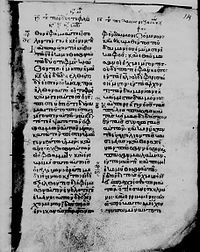Minuscule 828
| New Testament manuscript | |
 Page of the codex with text of Matthew 9:26-36 | |
| Text | Gospels |
|---|---|
| Date | 12th century |
| Script | Greek |
| Now at | Biblioteca della Badia |
| Size | 26.5 cm by 19.5 cm |
| Type | Caesarean text-type |
| Category | III |
| Note | beautiful; ƒ13 |
Minuscule 828 (in the
Description
The manuscript is a codex (precursor to the modern book), containing the text of the four Gospels on 176 parchment leaves (sized 26.5 cm by 19.5 cm).[3] The text is written in two columns per page, 27 lines per page.[3][4]
The text is divided according to the chapters (known as κεφαλαια / kephalai), and according to the smaller Ammonian Sections (234 sections in Mark, the last numbered section in 16:9). The numerals of the κεφαλαια are given in the left margin, and their titles (known as τιτλοι / titloi) at the top of the pages. The Ammonian Sections are given with a references to the Eusebian Canons (written under Ammonian Sections).[5]
It contains the Eusebian Canon tables at the beginning, tables of contents (also known as κεφαλαια) before each Gospel, lectionary markings,
According to biblical scholar Frederick Henry Ambrose Scrivener, the Eusebian Canon tables are written beautifully.[6]
Text
The Greek text of the codex has been considered as a representative of the
According to the Claremont Profile Method, it represents textual family ƒ13 in Luke 1, Luke 10, and Luke 20. It is fragmentary in Luke 10.[9]
In Matthew 9:35 it has the additional reading ἐν τῲ λαῷ καὶ πολλοὶ ἠκολούθησαν αὐτῷ "among the people, and many followed after Him".
It lacks the text of Matthew 16:2b–3, and the text of the Pericope Adulterae (John 7:53-8:11).[5]
History
Gregory dated the manuscript to the 12th century,[5] whereas other palaeographers dated it to the 11th century.[6] The manuscript is currently dated by the INTF to the 12th century.[4] The manuscript was written in Calabria,[5] possibly in Rhegium.[6]
The manuscript was examined and described by Antonio Rocci in 1882,[10] and later by Kirsopp Lake. It was added to the list of New Testament manuscripts by Scrivener (626)[6] and Gregory (828e). Gregory saw it in 1886.[5]
The manuscript is currently housed at the Biblioteca della Badia (A' α. 5), in Grottaferrata.[3][4]
See also
- List of New Testament minuscules
- Biblical manuscript
- Textual criticism
- Minuscule 826
References
- ^ von Soden, Hermann (1902). Die Schriften des neuen Testaments, in ihrer ältesten erreichbaren Textgestalt / hergestellt auf Grund ihrer Textgeschichte. Vol. 1. Berlin: Verlag von Alexander Duncker. p. 154.
- ^ Gregory, Caspar René (1908). Die griechischen Handschriften des Neuen Testament. Leipzig: J. C. Hinrichs. p. 76.
- ^ ISBN 3-11-011986-2.
- ^ a b c "Liste Handschriften". Münster: Institute for New Testament Textual Research. Retrieved 23 January 2011.
- ^ a b c d e f Gregory, Caspar René (1900). Textkritik des Neuen Testaments. Vol. 1. Leipzig: J.C. Hinrichs. p. 225.
- ^ a b c d e Scrivener, Frederick Henry Ambrose; Edward Miller (1894). A Plain Introduction to the Criticism of the New Testament. Vol. 1 (4 ed.). London: George Bell & Sons. p. 264.
- ISBN 0-19-516667-1.
- ^ ISBN 978-0-8028-4098-1.
- ^ ISBN 0-8028-1918-4.
- ^ Antonio Rocci, Codices cryptenses, seu Abbatiae Cryptae Ferratae in Tusculano digesti et illustrati (Tusculanum 1883), pp. 5–6.
Further reading
- Jacob Geerlings, Family 13 – The Ferrar Group: The Text According to Matthew, Studies and Documents 19, 1961.
- Silva Lake, Family 13(the Ferrar Group): The Text according to Mark with a collation of Codex 28 of the Gospels, Studies and Documents 11, 1941, pp. 20–21.
External links
- Online images of Minuscule 828 (CSNTM.
